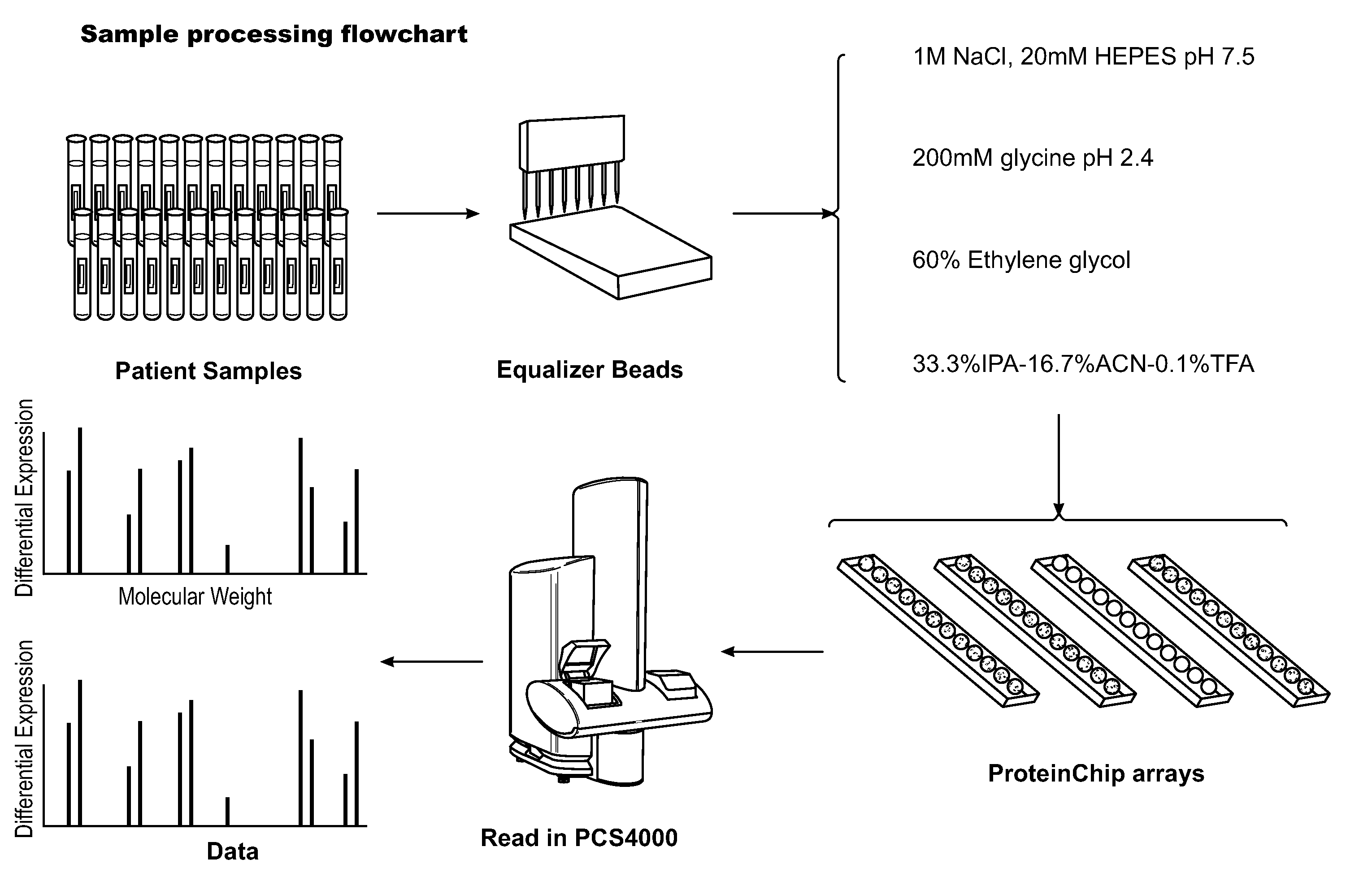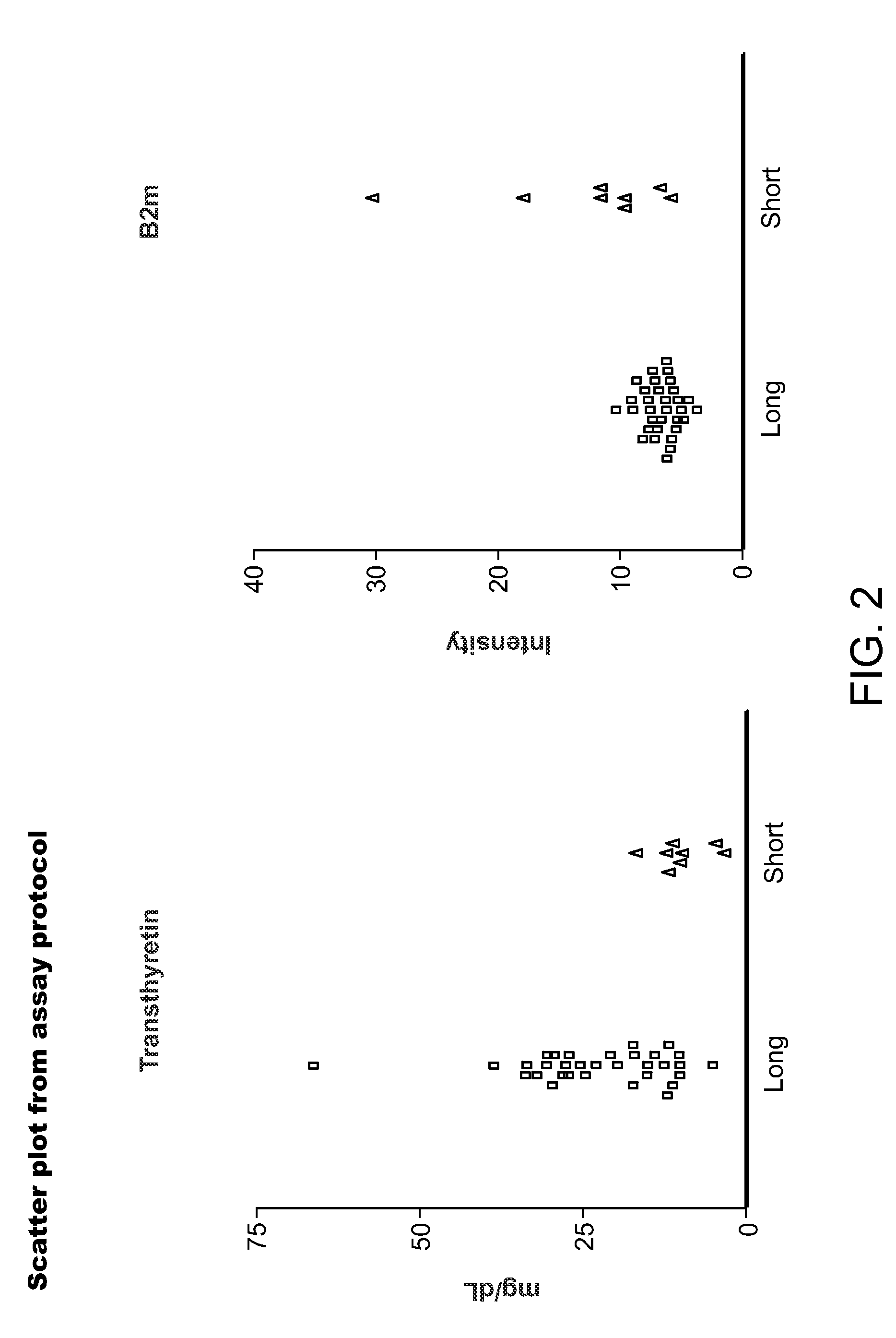Prognostic biomarkers in patients with ovarian cancer
a biomarker and ovarian cancer technology, applied in the field of determining the prognosis of patients with ovarian cancer, can solve the problems of no cost effective screening test, poor prognosis of ovarian cancer diagnosed, cost and risk associated with confirmatory diagnostic procedures, etc., and achieve the effect of limiting the number of markers detected
- Summary
- Abstract
- Description
- Claims
- Application Information
AI Technical Summary
Benefits of technology
Problems solved by technology
Method used
Image
Examples
example 1
Equalizer Bead Protocol: Sequential Elution
Swelling of the Beads
[0237]Add 20% methanol to dry beads, allow to swell overnight, gently rocking, at 4° C. Allow to settle by gravity. Remove fines. Add methanol, allow resin to settle, and remove fines. Wash with methanol several times. The beads can be stored swollen at 4° C. or −20° C. in 20% methanol indefinitely.
Preparing E-Bead Filter Plate
[0238]1. To each well of 96 well filtration plate(s) add 40 μL 50% E beads slurry.[0239]2. Apply vacuum for 30 seconds to drain off the organic solvent.[0240]3. Add 200 μL of deionized water and incubate with shaking for 5 min.[0241]4. Apply vacuum for 30 seconds to drain off the water.[0242]5. Add 200 μL of PBS and incubate with shaking for 5 min.[0243]6. Apply vacuum to for 30 seconds drain off the PBS.[0244]7. Add 200 μL of PBS and apply vacuum to drain off the PBS.[0245]8. Repeat the above step a total of 4 times. On the last wash apply the vacuum for 1 minute.
Sample Binding
[0246]1. Add 200 μL...
example 2
Prognosis of Subjects with Ovarian Cancer using a Panel of Seven Biomarkers
[0291]Ovarian cancer is the most lethal of gynecologic malignancies. The strongest determinant of long-term survival is stage at diagnosis. Patients with early stage disease have five year survival rates approaching 90% whereas patients with late stage disease have five year survival rates of ˜30%. Because ovarian cancer is a heterogeneous disease, new prognostic markers that correlate with patient survival may permit better subclassification of patients and therefore more tailored treatment. We have used proteomic profiling in an attempt to identify novel biomarkers that correlate with survival in a prospective cohort of women with newly diagnosed ovarian cancer.
[0292]Materials and Methods:
[0293]Patients: Women for this analysis were part of the Pelvic Mass Study at Rigshospitalet. Informed consent was obtained according to the Helsinki Protocol. Pre-operative serum was obtained, aliquotted, and frozen until...
PUM
| Property | Measurement | Unit |
|---|---|---|
| pH | aaaaa | aaaaa |
| pH | aaaaa | aaaaa |
| pH | aaaaa | aaaaa |
Abstract
Description
Claims
Application Information
 Login to View More
Login to View More - R&D
- Intellectual Property
- Life Sciences
- Materials
- Tech Scout
- Unparalleled Data Quality
- Higher Quality Content
- 60% Fewer Hallucinations
Browse by: Latest US Patents, China's latest patents, Technical Efficacy Thesaurus, Application Domain, Technology Topic, Popular Technical Reports.
© 2025 PatSnap. All rights reserved.Legal|Privacy policy|Modern Slavery Act Transparency Statement|Sitemap|About US| Contact US: help@patsnap.com



